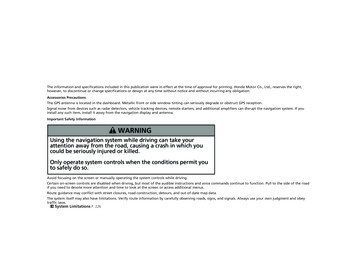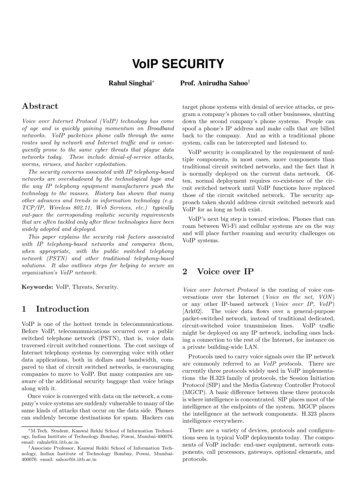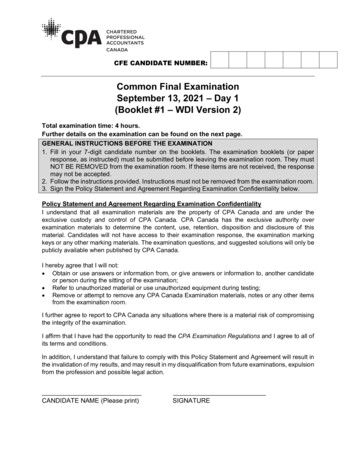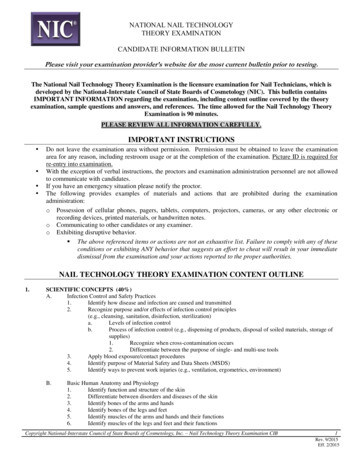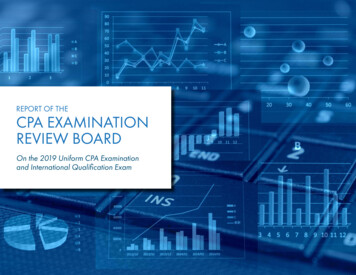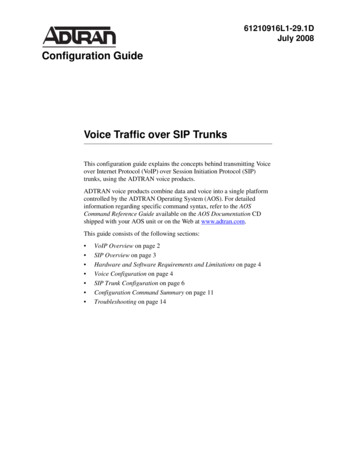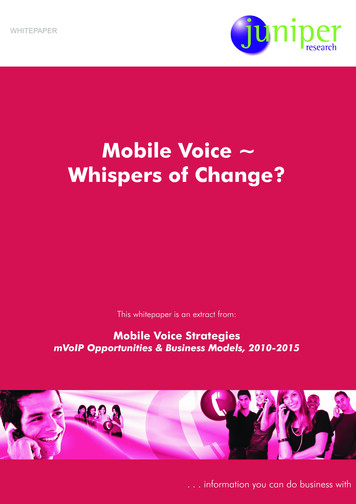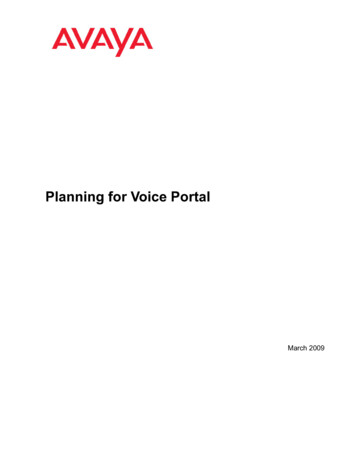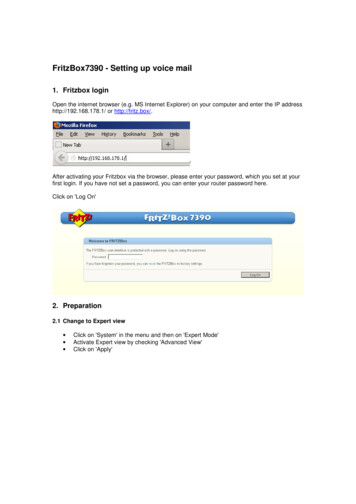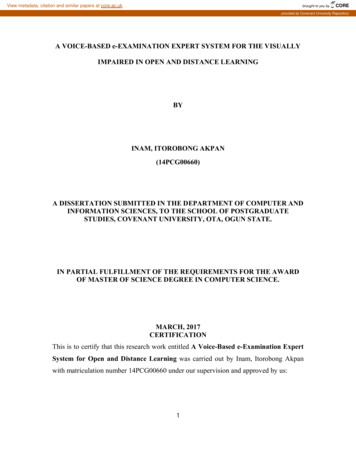
Transcription
View metadata, citation and similar papers at core.ac.ukbrought to you byCOREprovided by Covenant University RepositoryA VOICE-BASED e-EXAMINATION EXPERT SYSTEM FOR THE VISUALLYIMPAIRED IN OPEN AND DISTANCE LEARNINGBYINAM, ITOROBONG AKPAN(14PCG00660)A DISSERTATION SUBMITTED IN THE DEPARTMENT OF COMPUTER ANDINFORMATION SCIENCES, TO THE SCHOOL OF POSTGRADUATESTUDIES, COVENANT UNIVERSITY, OTA, OGUN STATE.IN PARTIAL FULFILLMENT OF THE REQUIREMENTS FOR THE AWARDOF MASTER OF SCIENCE DEGREE IN COMPUTER SCIENCE.MARCH, 2017CERTIFICATIONThis is to certify that this research work entitled A Voice-Based e-Examination ExpertSystem for Open and Distance Learning was carried out by Inam, Itorobong Akpanwith matriculation number 14PCG00660 under our supervision and approved by us:1
--------------------Signature andDr. OlawandeDaramolaCo-SupervisorDateDr. (Mrs) OlufunkeOladipupoHead of ignature and-----------------------------------Signature and2
DEDICATIONI dedicate this project to God Almighty for His sufficient grace, wisdom and knowledgegiven to me throughout my Master’s Degree Programme.3
DECLARATIONI hereby declare that this research project entitled A Voice-Based e-ExaminationExpert System for Open and Distance Learning was carried out by Inam, ItorobongAkpan with matriculation number 14PCG00660. The project is centered on an originalstudy in the department of Computer and Information Sciences, College of Science andTechnology, Covenant University, Ota, under the supervision of Dr. Ambrose AgbonAzeta and Dr. Olawande Daramola. Concepts of this research project are results of theresearch carried out by Inam, Itorobong Akpan and ideas of other researchers have beenfully ---Inam, Itorobong AkpanDr.AzetaSupervisorDateSignature and --Signature and4
Dr. ------------------Signature andACKNOWLEDGEMENTSMy sincere appreciation goes to God almighty, for helping me through my master’sDegree program. My gratitude also goes to the Chancellor, Covenant University, Dr.David Oyedepo for receiving the vision and mission of Covenant University that hastoday become a reality. My thanks also go to the entire Management of CovenantUniversity for seeing that the vision has been fulfilled towards accomplishing greatexcellence and thorough academic programme.I am thankful to my supervisors, Dr. Ambrose Agbon Azeta and Dr. Olawande Daramolafor their huge support and supervision throughout this research project. I wouldn’t havedone it without them. My thanks also go to the Head of Department of Computer andInformation Sciences (CIS), Dr. (Mrs) Olufunke Oladipupo, for her inspiration andsupport. I would like to say thank you to Dr. M. C. Agarana for the significant ideas andinsight he gave me in my research work. My appreciation goes to all the faculty membersof CIS department for their productive remarks during the numerous presentations wehad during the cause of this work. I will not fail to say a big thank you to all mycolleagues for their words of encouragement all through this research.Very big thanks go to my parents (Elder and Deaconess A. O. Inam) who kept inspiring5
me to drive on my vision and seeing to the completion of this research. Their prayers andfinancial support has brought me to where I am today. I will not forget my siblings,Mfon, Ndifreke, Wilson and Emediong who also stood by me during the course of thisprogram. All their phone calls and lovely messages have really helped me in forgingahead. I am also grateful to all my special friends for standing by me and encouraging mein times of challenges with their prayers and words of advice. Indeed it has been asmooth ride with you all. Thank you. TABLEOFCONTENTSPAGESTitlePage .iCertification .iiDedication .iiiDeclaration .ivAcknowledgements .vListofFigures6
.xiListofTables .xiiiAbstract .xivCHAPTER ONE: INTRODUCTION1.1BackgroundInformation .11.2StatementoftheProblem .31.3AimandObjectivesofthestudy .31.4ResearchMethodology .41.5SignificanceoftheStudy .61.6ScopeandLimitationoftheStudy 61.7ContributionstoKnowledge . 71.8DefinitionofTerms .71.9Organizationof7theDissertation
.8 CHAPTER TWO: LITERATURE REVIEW 2.1Introduction .9 2.2HistoricalPerspective 9 2.3SpeechTechnologies .10 andODLInterfaces2.3.1Text-to-Speech .10 2.3.2AutomaticSpeech .10 2.3.3CallControl 10 2.3.4SpeechRecognition .11 2.3.5StateChart .11 2.3.6SessionDescription .11 ofGrammar2.4SpeechInterface .11RecognitionXMLSpecificationXMLProtocolLanguages 2.4.1VoiceXML .12 2.4.1.1 VoiceXML Grammar .13 2.4.1.2VoiceXML8Gateway
.14 2.4.2SpeechApplication .14 2.4.3XHTML Voice .15 LanguageTags(SALT)2.5SpeechProcessing . 15 2.5.1Speech .16Recognition 2.5.2Speaker .18Recognition 2.5.3Speech .18 2.5.4Speech .19 2.6OverviewofVoice-based .20 2.7Voice-EnabledWeb .21 2.7.1Voice .21 2.7.2Voice .22CodingSynthesisSystemsStandardsPortalServers 2.8WebGenerations .22 2.9AnOverviewofIntelligent .249System
2.10Description and Architecture .25 2.11AReviewofODLand .27e-ExaminationSystems 2.12ReviewofExisting .30Voice-basedSystemsofanExpertSystem 2.12.1ExistingVoice-based .31 2.12.2ExistingVoice-based 31e-HealthSystems 2.12.3ExistingVoice-based 32e-LearningSystems 2.12.4ExistingVoice-based .33 thISO .34andSystemsSystemsPARADISECHAPTER THREE: SYSTEM ANALYSIS AND DESIGN3.1Introduction .353.2AnOverviewofCU .35ODL3.2.1ExistingSystem .35ODLin3.2.2Proposed .353.3Requirements .3610CUSystemSpecification
3.3.1Functional .36Requirements3.3.2Non-functional 36Requirements3.4Requirements .373.5The Proposed .38Voice-basede-ExaminationSystem3.6Requirements .39AnalysisFrameworkModelling3.61UseCase 40Model3.6.2ClassStructure .40Model3.6.3Behavioural 41Model3.6.3.1Sequence .41Model3.6.3.2Activity .42Model3.7Data 433.7.1Database 433.7.2Entity .45Relationship3.8System elingArchitectureSequence
.48CHAPTER FOUR: SYSTEM IMPLEMENTATION AND EVALUATION4.1Introduction .494.2System 49Requirements4.2.1Hardware 49Requirements4.2.2Server-side .49SoftwareRequirements4.3Toolsusedfor .50Development4.3.1Voxeo 50Prophecy4.3.2User .50Interfaces4.3.2.1VoiceUser .50Interface(VUI)4.3.2.2WebUser 52Interface(WUI)Shell(JESS)4.3.3JavaExpertSystem 534.4Testingand .55Deployment4.5Implementation SO9241
.594.7Resultsand .614.8PerformanceEvaluation .64usingDiscussionPARADISE4.9 Threats to Validity 674.9.1ThreatstoInternal .68Validity4.9.2ThreatstoStatistical .68ValidityConclusion4.9.3Threatsto .69ConstructValidity4.9.4Threatsto 69ExternalValidityCHAPTER FIVE: SUMMARY, CONCLUSION AND RECOMMENDATIONS5.1Summary .705.2Conclusion .705.3Recommendations .715.4Future .71REFERENCES 7213work
APPENDIXA:UML .81DiagramsAPPENDIXB:Listof 87AbbreviationsAPPENDIXC:System 1.1WorkflowoftheResearchMethodologyofVoiceXML .5Figure2.1:ArchitecturalModel 13Figure2.2:SpeechProcessing .1614Classification
Figure2.3:SpeechSynthesisFlow .19Figure2.4:BasicArchitectureofanExpertSystem .26Figure 3.1: Proposed Framework for the Voice-based e-Examination System 38Figure3.2:AUseCaseDiagramfortheStudentandAdmin mDatabaseExaminationProcess 41Figure3.4:ASequenceDiagramfor eSystem .43Figure 3.6: Entity Relationship diagram for the database using Crow’s Foot Notation .46Figure 3.7: Deployment Architecture for Voice-based e-Examination System .47Figure 3.8: Pseudocode for the Dialogue Sequence .48Figure 4.1: Typical Scenario of call flow/interaction with the system using a DialogueTree .51Figure 4.2: Shuffling Algorithm for generating random questions .5215
ion 53Figure4.4:Samplemainmenurule .54Figure 4.5: Sample rule for comparing students’ answer with the correct answer .55Figure4.6:Sampleruleformarkingstudents’answer .55Figure4.7:VoxeoProphecySIPPhone nWebInterface ion rmWebInterface 59Figure 4.11: Usability Analysis of the system for all evaluated attributes .63Figure4.12:UsabilityAnalysis .63of16theSysteminPercentage
LIST OF TABLESPAGESTable 1.1: Objectives and Methodology Mapping . .6Table 3.1: Requirements and Description .37Table 3.2: Module and Requirement Supported17
.38Table3.3:StudentInformation .44Table3.4:ExaminationQuestionsInformation 44Table3.5:ResultInformation .45Table3.6:CourseInformation ersonaldata gscale .60Table4.3:SurveyResults atrixinstantiation .64Table4.5:AttributeValue 6418
ABSTRACTOpen and Distance learning (ODL) is a means of acquiring knowledge withoutnecessarily being in normal direct communication with the instructor. The aim of ODL isto increase access to education and by extension online examination for those who havedifficulty accessing education such as the poor, illiterate, less privileged, and those withlocation and financial constraints. Most electronic examination (e-examination) systemsare web-based, and studies on the accessibility level of distance education show that webbased form of examination does not fully meet the needs of visually impaired persons.Voice-based systems allow users access to information on the internet over a phoneinterface. Prior studies on ODL e-examination systems that make use of voice userinterface do not sufficiently exhibit intelligent form of assessment, which diminishes therigour of examination. The objective of this project is to improve on the achievements ofprevious studies by providing a voice-based e-examination expert system for ODL thatdemonstrates shuffling of examination questions to learners. The study employs acombination of technologies such as system design and modeling using UnifiedModeling Language (UML), server side scripting, voice-based system development, datamanagement and rule-based reasoning in order to develop a prototype voice-based eexamination expert system for ODL. The developed system was evaluated to determinethe level of performance and usability. The result of the usability evaluation showed thatthe developed application has an ‘average usability’ rating of 3.48 out of 5 scales. Theperformance evaluation of the system using Paradigm for Dialogue System Evaluation(PARADISE) gave a score of 4.78 on a scale of 5 as the maximum. This shows that thevoice-based e-examination system will not only complement the existing web-based19
a voice-based e-examination expert system for the visually impaired in open and distance learning by inam, itorobong akpan (14pcg00660) a dissertation submitted in the department of computer and
